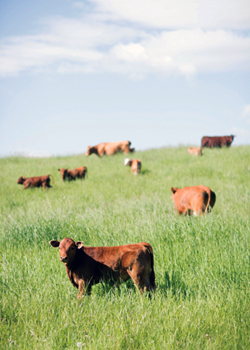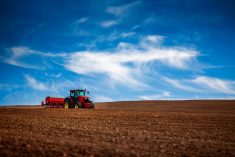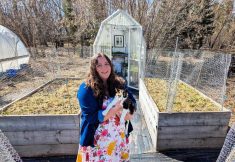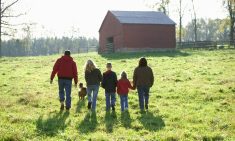Cherie Copithorne-Barnes knows the feeling. Ranching at Jumping Pound, Alberta, just 30 minutes west of Calgary, she looks at today’s agriculture and sees it producing the healthiest, cheapest food the world has ever known.
But she also looks around her and sees an agriculture under intense scrutiny from the beneficiaries of that food, and also under pressure from the neighbours who choose to share the space where farmers need to conduct their business.
Read Also

Farmland values: assumptions and realities
Where farmland values are headed and what decisions farmers should make
She doesn’t have to look far. “We are next-door neighbours to a million people,” Copithorne-Barnes says. “We have a highly affluent community that lives around us because of the oil patch. They have paid a million dollars plus to live on their property.”
But, Copithorne-Barnes adds, “They don’t work or socialize here… and they get upset when the tires of their Mercedes Benzes get covered in cow manure.”
Copithorne-Barnes’s great-grandfather, Richard Copithorne came to Alberta in 1884 from Cork, Ireland and began assembling what became the nucleus of the 28,000 acres that CL Ranches grazes today. “Most of it is leased and includes some Crown and First Nations land,” Copithorne-Barnes says. “We have relationships that have been built over three generations.”
Yet increasingly, her neighbours are also three generations from the farm.
Their lack of knowledge of agriculture and of what ranching is about, and how it works, is threatening the social licence that allows producers to do what they do, says Copithorne-Barnes, who farms with husband Tim and her 77-year-old father, Marshall Copithorne.
- From the Alberta Farmer Express: How to answer those tough agricultural questions from your urban neighbours
“My family has been in this community for 130 years. Everybody around me has been here no more than 30, yet their opinions are now becoming critical.
“Corporations and politicians are listening to them, and there’s a reason for that. Corporations have realized, well in advance of us producers, that it’s important to figure out what our social responsibility is,” Copithorne-Barnes says.
“We as producers have to start catching up on this because it’s not going away any time soon,” she says. “Happy customers are a result of being happy with what they see.”
Copithorne-Barnes realizes the future of her ranching tradition is being affected by influences that often have nothing to do with the realities of raising cattle, so she also knows that the voices of cattle producers and other farmers must start being heard above the din.
It’s the reason she is chair of the Canadian Round Table for Sustainable Beef, and why she is a strong advocate of the industry.
- From the Canadian Cattlemen: Advocacy on the front lines
Animal welfare issues are a huge concern for consumers; they are driving changes throughout the livestock industry. At the producer level, the revised Code of Practice for the Care and Handling of Beef Cattle, which was released by the National Farm Animal Care Council in August 2013, has new requirements for the use of pain control during painful procedures such as castration or dehorning.
At the other end of the chain, A&W restaurants recently launched its “Better Beef” campaign claiming that its beef has no added hormones or steroids, and McDonald’s Restaurants has announced it will begin purchasing verified sustainable beef by December 2016.
- More Country Guide: A&W Canada tightens beef sourcing requirements
- From the Alberta Farmer Express: Canada picked for sustainable beef pilot
Copithorne-Barnes has come to understand first hand the power that consumers and her neighbours have to influence how she produces her product.
CL Ranches, in part because it’s so close to Calgary, gets a lot of requests for tours. These include requests from the Canadian Food Inspection Agency and Canada Beef, as well as from the farm’s customers, such as Spring Creek and Sobeys who bring their clients to see a working cattle ranch.
“One group was from A&W and what they really wanted to understand was how to produce hormone-free cattle,” says Copithorne-Barnes. After the tour, she asked why they were so interested in hormone free, which the ranch has been producing for 17 years. “They said they’d been watching their Twitter accounts — and enough of their customers were asking for hormone-free beef that they decided to go that route. You may or may not agree with what their final marketing plan was — but all they were doing was listening to what their consumers were asking for.”
About a year ago Spring Creek brought out its Sobeys meat team — or so she thought — for a tour of the ranch. An English guy with the entourage asked endless questions about the welfare of the animals and videotaped some of Copithorne-Barnes’ answers. “As we toured the empty feedlot the guy asked me, how do you feel about putting your cows in these pens after they have been free and running around all summer?” she recalls. “I told him you’re here in July and right now it’s green and beautiful. Picture yourself here in January, when it’s -40 and the wind’s blowing. You’d see every pen filled with calves; they’d have fresh feed in front of them; they’d be sleeping on good, clean bedding and there’s lots of shelter for them.”
Four weeks later she found out the English guy had been the market development co-ordinator for celebrity chef Jamie Oliver, sent on a scouting mission to look at how some of the beef purchased by Sobeys was produced and to determine if Oliver would allow his name to be associated with Sobeys meat.
The video of Copithorne-Barnes explaining how she raised her animals was already on Sobeys website. “I got a million-dollar endorsement that I didn’t ask for,” she says. “But I began to wonder what was going on here, and it didn’t take me long to realize that Sobeys was trying to achieve what every retailer wants. Jamie Oliver has the ability to satisfy its customers — he has 3.7 million followers right now. What retailer in their right mind wouldn’t like a guy like Jamie Oliver promoting them?”
Such experiences made Copithorne-Barnes realize how important it is for farmers to be a part of the conversation about food and how it’s produced. “Whether you’re in the specialty stream or the commodity stream, the story that’s being told can affect all of us,” she says. “Retailers get this. They’re closer than ever to their customers… they’re in tune with this new millennial generation and they function in the social media realm. They engage them and educate them in a way they understand — not by preaching — but by listening to their concerns. That’s what we have to start doing.”
Nor is it just production methods that producers need to explain, says Copithorne-Barnes, but also farmers’ social commitment to the rural communities they live in, as another incident taught her.
Copithorne-Barnes was shocked by a local radio report last October that her lease on 3,500 acres of public lands, which provided summer grazing for 550 cow-calf pairs, was about to be withdrawn because the Alberta government was expropriating the land to build a new ring road around Calgary.
Three weeks and many phone calls later the province confirmed the story, but it still wasn’t able to explain exactly what it would mean for the ranch, and she is still negotiating a new lease arrangement. As word spread in the community, however, an open house was held on the plan, which would impact a lot of people especially if, as expected, it blocks the road allowances that the community wanted to develop as emergency exits in case of flooding.
“One community member stood up and said, ‘I can’t believe CL Ranches would allow this to happen to that lease without consulting us and telling us, and if I hear that CL Ranches is going to get any compensation while my private land is being devalued, I am going to sue them and the county and the province,’” recalls Copithorne-Barnes. “I was completely taken aback. These were people whose kids go to school with my kids — they are my friends and neighbours and they were ready to sue me because they didn’t understand what was going on… If I hadn’t gone to that meeting and explained it, I can’t imagine how it would have played out.”
It was a useful reminder, says Copithorne-Barnes, that in the absence of someone telling the true story, rumour and supposition will often fill up the void. “The message is that we, as individual producers, have to get out and tell our stories,” she says. “We might think the public is not going to come knocking at our door but the reality is, they are.”
Despite the constant encroachment of an urban population — or perhaps because of it — Copithorne-Barnes is one of the very few of her generation, including her five siblings, who has decided to stay in the area and ranch. “This ranch is in my blood,” she admits. “I am one of those crazy people who will probably die dead broke fighting for this place, but I wouldn’t have it any other way.”
She’s not afraid to face challenges, and CL Ranches has a few unique ones. Its location, at an elevation that averages around 4,000 feet, means the cost of keeping cattle is higher than in most areas. The ranch only averages 90 frost-free days and usually ends up feeding cattle for around 5-1/2 months. They have used genetics — developing what they call the CL SuperCross Breed — to help them stay in the game.
“CL has always strived to build the cow to suit our environment,” says Copithorne-Barnes. “With such a short growing season, we must have cattle that don’t require high-energy or high-input diets… Our cows must be able to winter economically, remain fertile and raise a calf that weans heavy.”
The SuperCross was originally a breed made up of Hereford, Simmental and Braunveih, but the cattle began to become too large and had too high a feed requirement so the ranch brought in a British breed, Sussex with better forage efficiency.
“The Sussex downsized the cows from 1,400 lbs. back down to 1,250 lbs.,” explains Copithorne-Barnes. “Genetics for us is always a continuous journey. We’ve achieved the appropriate-size cow again. Now, I’m looking to improve once again on performance without losing the fertility and structure.”
The ranch follows a strict and unforgiving cull policy. All open cows and those in poor condition are sold. In fact, it was this policy, plus the fact that the ranch has always been in the bull-breeding business, that led it to supply the naturally raised, hormone-free market in the first place.
“We don’t castrate the bull calves coming off our cows,” says Copithorne-Barnes. “The bulls remain on grass until the snow no longer allows them to perform efficiently, then they’re brought into the feedlot and we select the top 25 per cent performing bulls, leaving us with the bottom 75 per cent that must be castrated and fed out.”
Originally, the ranch fed them as bulls and sold them into the EU market, but this ended with the BSE crisis, meaning they had to find another avenue to sell these bulls. “We went down the path of keeping them hormone free, castrating them and selling them into the ‘Natural Markets,’” says Copithorne-Barnes.
Although this has worked well in the past, with the new Beef Code of Practice it may become a practice that’s less viable. “We will no longer be able to castrate these bulls without full pain mitigation starting January 1, 2016, and this simply adds to the cost of raising natural beef,” says Copithorne-Barnes. “In my opinion, as consumers begin to ask for more natural products, any premiums we had received in the past will no longer be as readily available as this market expands, and I worry that it might not remain viable because of this.”
The challenges seem endless sometimes, admits Copithorne-Barnes. “I spend over 50 per cent of my time managing the non-agricultural events that occur daily. For example, I have a road construction crew parked outside my front gate about to dig up the only road I have that doesn’t have a road ban on it, not to mention 600 cows calving that have to be fed. It never ends here.”
To survive, the ranch has had to be resourceful. “Our other, diversified operations simply help pay the bills,” says Copithorne-Barnes. “We use the natural resources that are readily available — space and gravel.”
The ranch is only 35 minutes from downtown Calgary and the airport, and offers some panoramic views of the Rocky Mountains, so it’s not surprising it was discovered by the movie industry. In 1991, producers for the Lonesome Dove television series, after a lot of scouting throughout Alberta, approached the ranch about building a movie set on the property.
“They needed a site that was completely isolated and close to Calgary, because in those days they would have to send the rolls of film to the airport for shipment to be edited,” says Copithorne-Barnes.
The production company built a complete, circa 1850-1930 western townsite and studio set, and produced the TV series there for six years, after which the ranch bought it for about 10 cents on the dollar, built a warehouse to store the set decorations and props, and began to rent it out. “Movie companies come in and rent the location and all infrastructure, which they build and by contract must leave,” says Copithorne-Barnes. “All it takes to attract them is the 180-degree, unobstructed view of the mountains.”
The other diversification at the ranch is a gravel business, which takes advantage of a huge gravel resource located along the banks of the Jumping Pound Creek that runs some 11 miles through the property.
Nor does the future for Copithorne-Barnes look to be getting any less complicated. “There are so many changes going on around us here with regards to land use regulations starting to weigh in, each day makes you wonder if I am truly in the ranch business or the real estate holding business,” she says. “There’s talk of making eight lanes on the Trans-Canada and four lanes on Highway 22 to the east of us, and all that does is complicate our operations by making it tough to move around. We are starting to look at non-agricultural projects that will not affect the cows… we know that these changes are inevitable and therefore instead of fighting change, we must look at ways of surviving them.”
In part, that’s because Copithorne-Barnes like other farmers has the next generation in mind, although she admits she struggles with the question of whether to encourage her children, Josh, 14 and Courtney, 11 to carry on the ranch. “Ultimately, I will leave it up to them,” she says. “If they decide that they would rather do something else, I would never hold it against them.”

















